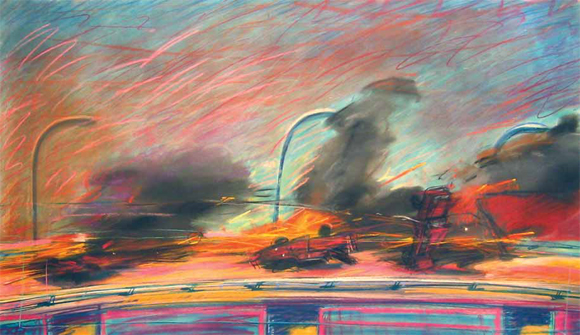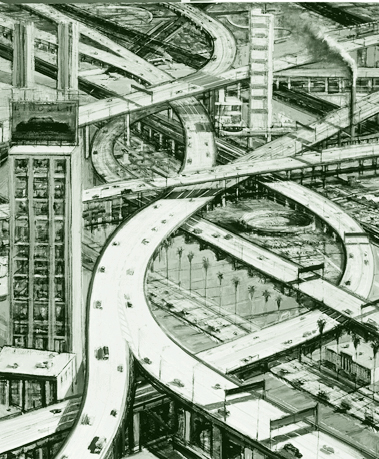
As the Los Angeles Chapter AIA is now deeply involved with preparations for this year’s AIA National Convention, June 8–10, most staff time and board priorities are directed to programming the Host Party, coordinating local design awards with the national program, arranging a multitude of tours of Southern California’s cherished assets, and identifying a healthy list of outstanding Presidential awardees for recognition at the convention. Yet, during my tenure as president, I am intent on addressing an overall theme for the year, as previous presidents have done. In attempting to understand this, one needs to reflect on our firm’s work here in Los Angeles over the past twenty-some-odd years and to see it in the context of the region. This seems appropriate, since much of our work is in urban design as well as in architecture. We view our projects in an understanding of the broader social, cultural, and economic context. With this in mind, my focus centers on the civility of our city.
In the early nineties, my partner, Scott Johnson, and I found ourselves planning commercial projects that proposed significant densities in various parts of the Los Angeles region. At the time, we were working with three nationally prominent developers in significantly sized projects in the Warner Center area of the Valley. Although Los Angeles has one of the biggest public bus systems in the U.S., we are dominated by a dependence on the private automobile. Consequently, we found ourselves evaluating intersection capacities and roadway widths with a goal of widening vehicle rights-of-way to allow for larger densities. This seemed nuts to us. What about the pedestrian? What about spaces for people, not cars? Where are the plazas and parks in this city?
I asked our office researcher, Katherine Rinne, to compare the amount of public park space in Los Angeles to other cities. She came back with an astonishing result. Los Angeles has approximately half as much space devoted to public parks as Boston and San Francisco, one-third that of Seattle, and one-quarter that of New York City. It became apparent to us that Los Angeles, often described as a “garden city,” is in fact a city of private gardens, consisting of private back yards with barbeques and frequently a swimming pool. With such a focus on the “private,” this city’s “public” has been relegated to third- or fourth-tier importance, with token gestures to place-making as found in suburban malls, fake main streets like the Grove, or entertainment connectors like City Walk in Universal City. We seem to be dominated by a culture of “hyper individualism,” at the expense of the social interaction that promotes a high degree of civility.

David Hockney, Ron Davis, Ed Moses and other L.A. artists have remarked positively about the “freedom” Los Angeles offers the artist for individual expression. Yet, what is the balance between an emphasis on individual expression and collective will? Can this city bear another riot (’65 and ’92); or the fear between people expressed in the movie, Crash, this year’s Academy Award winner for best film; or what was similarly expressed in the earlier film Grand Canyon, which explained the deep abyss we feel between neighborhoods? A kind of isolationism exists in our city—a disjointedness in the “public realm” between roads and buildings as expressed in paintings by Wayne Thiebaud, or a frustration with the private automobile as expressed by Carlos Almarez’s pastels of crashing cars.
“Can we all get along?” Rodney King asked during the ’92 riots. We have so much separation—we have no places to see and greet each other or, as Jennifer Lee puts it in her book Civility and the City, for opportunities to negotiate everyday life between peoples of differing backgrounds. Based upon her work in Philadelphia and New York City neighborhoods, Lee found significant evidence that these daily urban interactions allow people to get to know each other, breaking down misunderstandings, stereotypes, and fears.

An important point to remember is that our city is relatively new and terribly raw. It has not benefited from eras of civic-mindedness such as the City Beautiful Movement of the late nineteenth century, which shaped cities like San Francisco, Boston, New York, and Chicago. Consequently, the L.A. city metro region became filled out in an ad hoc fashion during the years following World War II, when there was a call for providing soldiers and their families with the American dream house. Los Angeles needs complexity—complexity that necessitates social interaction at all levels, whether at the store purchasing groceries, a casual encounter in public transit, a gathering in a public plaza or park. People need to become acquainted, learn how to respect each other, and realize that everyone benefits from developing and nurturing the social contract between citizens of the city. This contract is ultimately more important than the self-centered culture of individual gratification that we have today.

Los Angeles needs a renewed commitment to rebuild and maintain civic space in our great city. I believe that our new mayor, Antonio Villaraigosa, has the energy and vision to accomplish this. He has become a leading advocate for reestablishing a broad range of transit initiatives, including reinstatement of the subway line under Wilshire Boulevard from the downtown business district to Santa Monica and the extension of light rail and exclusive busways such as the Orange Line in the Valley. He is also a great supporter of public parks, the Grand Avenue cultural district, and L.A. River projects—significant endeavors underway that will help cultivate civility in the city.
Two new emerging public park projects have exciting potential—one in northeast Chinatown, and the other at the Department of Veterans Affairs (V.A.) in West L.A. Both are offerings to all of Los Angeles’ citizens.
The “Cornfield,” located between north Broadway and Spring Street near Elysian Park and the L.A. River, is a thirty-two-acre brownfield site which was previously home to Southern Pacific railroad yards and the site of an early cornfield during the Pueblo era. The property was rescued by the State Parks Department, who put up enough funding to purchase the land from a developer intent on turning it into an industrial park. Situated between the original Pueblo and the River, it is teeming with memories. Portola’s original encampment in 1769 at the narrows of the L.A. River was immediately north of the Cornfield site. The original Zanja Madre (“mother water trench”) that provided water to the Pueblo was located along the northwestern boundaries of the site, and the first water wheel and reservoir were located there not far from the Gonzalez adobe, one of the first homes in the Pueblo era. Thus, the site holds a great deal of promise for recalling a collective memory of the city origins. Now the subject of a request for proposals, the State is positioning the site for a new landscape design that will include interpretative elements as well as satisfying local residents’ desires for recreational space.
The Veterans Affairs property in Westwood is ideally situated to become the “Great Westside Park.” Originally called the “Soldiers Home,” it is similar to eleven others built nationally. Like the Yountville Soldiers Home in Napa Valley, it was built for recuperating soldiers following the Civil War. Over the years, these properties have become increasingly public. It is apparent that the V.A. hopes to generate additional revenues from future use of the property. Councilman Bill Rosendahl and former Mayor Richard Riordan, who is championing the property as a new park, both support the property for veterans’ services and open-space uses. Where revenue-producing activities are necessary, they have stated these uses should be compatible with local community goals for the property, i.e., museums, galleries, and medical-related services to the hospital south of Wilshire. Over the years, the property has suffered from a piecemeal approach to development, and an overall vision is critically needed for the entire site. Peter Mullins, Tom Jones, Brad Freeman, and the Veterans Park Conservancy have supported the beginnings of this open space idea by developing a small park at the very important San Vicente/Wilshire Boulevard corner, and, hopefully, with Riordan’s efforts to develop a broad vision, the V.A. Park can be realized.
Great cities of the world have great public spaces. Their civility depends upon them. Well-distributed parks, walkable streets, public plazas, and effective public transit all contribute to the life of the city and the ways in which people interact with each other. They enable the development of a civic culture that supports a shared collective will. Such spaces, places, and occurrences help to establish mutual understanding and help us, as Rodney King put it, “all get along.”
Author William Fain, Jr., FAIA, a native Californian, is the Director of Urban Design and Planning and Managing Partner of Johnson Fain. His urban design work has received awards from the AIA and Progressive Architecture, and his Greenways Plan for the Los Angeles metropolitan area was shown at MOCA in their Urban Revision Show. He has won two Fellowships from the National Endowment for the Arts and was a Rome Prize Fellow in 2002. He has taught at USC, SCI-Arc, and UCLA Extension.
Originally published 2nd quarter 2006 in arcCA 06.2, “L.A.”





